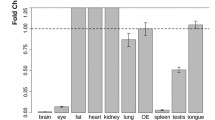Summary
During development of the olfactory epithelium in the chick embryo, the cell coat is revealed by treatment with Ruthenium red. On day 4 of incubation the developing sensory epithelium displays a thicker apical and basal cell coat than the neighbouring head ectoderm. The lateral cell coat is of equal thickness in both epithelia. The apical cell coat of the olfactory epithelium increases in thickness from day 4 to day 19 of embryonic life, finally attaining a thickness of about 55 nm.
Similar content being viewed by others
References
Anghileri LJ, Dermietzel R (1976) Cell coat in tumor cells. Effects of trypsin and EDTA: A biochemical and morphological study. Oncology 33:17–23
Banerjee SD, Cohn RH, Bernfield MR (1977) Basal lamina of embryonic salivary epithelia. Production by the epithelium and role in maintaining lobular morphology. J Cell Biol 73:445–463
Bannister LH (1974) Possible functions of mucus at gustatory and olfactory surfaces. In: Poynder TM (ed) Transduction mechanisms of chemoreception. Information Retrieval Ltd, London, pp 39–48
Beets MGJ (1978) Structure-activity relationships in human chemoreception. Applied Science Publishers Ltd, London
Bernfield MR, Banerjee SD (1972) Acid mucopolysaccharide (glycosaminoglycan) at the epithelialmesenchymal interface of mouse embryo salivary glands. J Cell Biol 52:664–673
Bernfield MR, Banerjee SD, Cohn RH (1972) Dependence of salivary epithelial morphology and branching morphogenesis upon acid mucopolysaccharide-protein (proteoglycan) at the epithelial surface. J Cell Biol 52:674–689
Blanquet PR (1976 a) Ultrahistochemical study on the ruthenium red surface staining. I. Processes which give rise to electron-dense marker. Histochemistry 47:63–78
Blanquet PR (1976 b) Ultrahistochemical study on the ruthenium red surface staining. II. Nature and affinity of the electron dense marker. Histochemistry 47:175–189
Boelens H (1976) Molecular structure and olfactive properties. In: Benz G (ed) Structure-activity relationship in chemoreception. Information Retrieval Ltd, London, pp 197–210
Breipohl W, Mendoza AS (1977) Die Entwicklung der olfaktorischen Plakode beim Haushuhn. Beitr Elektronenmikroskop Direktabb Oberfl 10:551–556
Cohn RH, Banerjee SD, Bernfield MR (1977) Basal lamina of embryonic salivary epithelia. Nature of glycosaminoglycan and organization of extracellular materials. J Cell Biol 73:464–478
El-Hifnawi E (1978) Direct contact at the epithelial-mesenchymal interface during the early development of the chicken ciliary epithelium. Exp Eye Res 27:691–700
Glees P, Spoerri PE (1978) Surface processes of olfactory receptors. Cell Tissue Res 188:149–152
Gnatzy W, Weber KM (1978) Tormogen cell and receptor-lymph space in insect olfactory sensilla. Cell Tissue Res 189:549–554
Herberhold C (1969) Adsorption von Geruchssubstanzen auf Thermistoren. Archiv Klin Exp Ohren- Nasen- und Kehlkopfheilk 194:435–440
Laurent TC (1970) Structure of hyaluronic acid. In: Balázs EA (ed), Chemistry and molecular biology of the intercellular matrix. Academic Press, London and New York, pp 703–732
Luft JH (1971a) Ruthenium red and violet. I. Chemistry, purification, methods of use for electron microscopy and mechanism of action. Anat Rec 171:347–368
Luft JH (1971b) Ruthenium red and violet. II. Fine structural localization in animal tissues. Anat Rec 171:369–416
Luft JH (1976) The structure and properties of the cell surface coat. Int Rev Cytol 45:291–370
Martinez-Palomo A, Brailovsky C (1968) Surface layer in tumor cells transformed by Adeno-12 and SV40 viruses. Virology 34:379–382
Martinez-Palomo A (1970) The surface coats of animal cells. Int Rev Cytol 29:29–75
Meier S (1978a) Development of the embryonic chick otic placode. I. Light microscopic analysis. Anat Rec 191:447–458
Meier S (1978b) Development of the embryonic chick otic placode. II. Electron microscopic analysis. Anat Rec 191:459–478
Mendoza AS (1979) Die Ausreifung des Riechepithels beim Huhn (Gallus gallus). Eine deskriptive morphologische Studie. Inauguraldissertation, Essen
Mestres P, Meiler K, Breipohl W (1973) Elektronenmikroskopische Befunde zum cell coat unter normalen und experimentellen Bedingungen. Verh Anat Ges 67:489–494
Morgan HR (1968) Ultrastructure of the surfaces of cells infected with avian leukosis-sarcoma viruses. J Virology 2:1133–1146
Reynolds ES (1963) The use of lead citrate at high pH as an electron-opaque stain in electron microscopy. J Cell Biol 17:208–212
Author information
Authors and Affiliations
Additional information
This paper is dedicated to Dr. A.J. Zamora
Portions of this paper were taken from the thesis by the author in fulfilment of the requirement for the degree of Dr. rer. nat. at the University of Essen Supported by the Deutsche Forschungsgemeinschaft (SFB114)
Rights and permissions
About this article
Cite this article
Mendoza, A.S. The cell coat of the developing olfactory epithelium in the chick. Cell Tissue Res. 207, 227–232 (1980). https://doi.org/10.1007/BF00237807
Accepted:
Issue Date:
DOI: https://doi.org/10.1007/BF00237807




